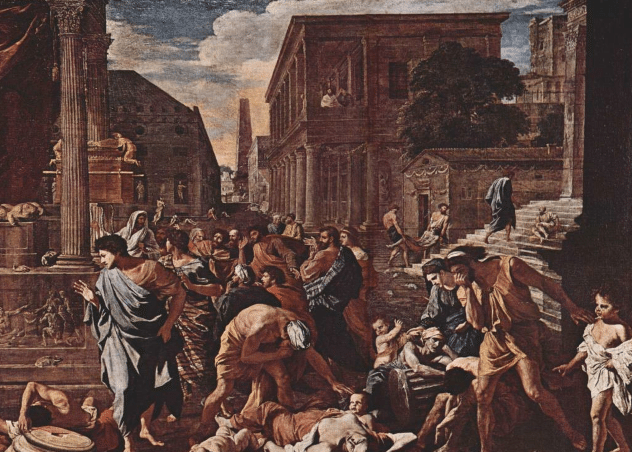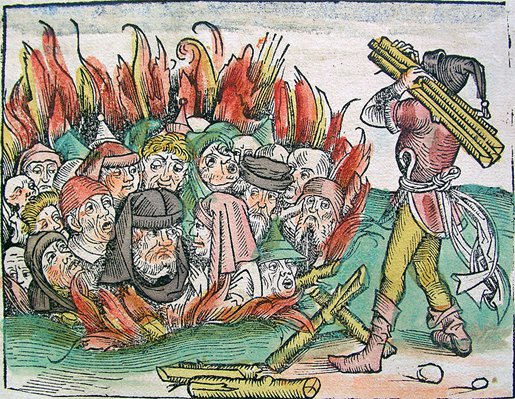We’ve all heard of it, but what was it? When did it happen? Where did it come from? Who did it affect? What did contemporaries at the time think of it? Read on to find out!
The Black Death or plague?
The Black Death is the name given to the strain of bubonic plague (or pneumonic plague, or even anthrax as some controversial historians have argued) which ravaged Europe from 1346-53. The peak years of the Black Death are generally seen as 1348-52, and it is, to this day, the most devastating natural disaster in recorded human history: estimates of between a third and a half of Europe’s population died from the Black Death.

Note that Poland and Central Europe remained relatively unaffected – this
was because there were very few trade routes, and people fleeing towns and cities rarely got that far into Central Europe.
However, the Black Death was not the first instance of a major plague pandemic in European history. In 541, the Plague of Justinian (named after the Roman Emperor at the time) hit the Byzantine Empire and the Eastern European Empire, causing mass deaths – contemporary sources largely over-exaggerated figures and estimated between 25 and 100 million people were killed. So, if this was the case, why is the Black Death still so significant?

The Plague of Justinian lasted for a mere year, until 542. However, waves of bubonic plague in the aftermath of the Black Death continued to hit Europe throughout the fourteenth century, and even bouts of it returned in the fifteenth and sixteenth centuries. The cultural, social and economic impacts of the Black Death were enormous, as we shall soon see!
What was it?
The simple answer is bubonic plague. But what is bubonic plague? The most recognisable symptom were buboes – huge, black boils which affected the lymph nodes: primarily the neck, groin and armpits. Other symptoms included those similar to a fever. During the Black Death, when a person contracted it, they could expect to live for anywhere between two days to a week, usually in excruciating pain from the buboes which could burst.
Where did it come from?
The Black Death is often attributed to the ‘Tartars’ – more commonly known as the Mongols. Although it likely originated in China, the Mongols spread it rapidly to India and then into Europe. The Black Death was originally thought to have been carried by black rats, rattus rattus. However, it was actually fleas on the rats who transmitted it.
Europe and the Black Death
The first recorded case of the Black Death in Europe was when it reached the Genoese colony of Caffa, in the Crimea, which was under siege by the Mongols in 1346. In one of the most notorious cases of biological warfare, the Mongols catapulted plague-ridden corpses over the city walls of Caffa in order to break its resistance: it worked, and the Genoese defenders of the city rowed away for safety – in a huge mistake which inadvertently spread the plague to the rest of Europe in huge swathes over the next decade.

remembered incidences of biological warfare.
The plague had reached a key Mediterranean port by October 1347: Messina in Sicily. This was one of the worst affected places in Europe during the Black Death, because it was a key trading route. With more ships continuing to come in, more people were spreading it to other areas in Europe and North Africa.
By January 1348, the plague had reached Genoa: a major trading hub and colony in Europe. It had reached Genoa by a galley which had come from Caffa. The Genoese governors – in a move which is somewhat reflective of governments in today’s current Coronavirus pandemic – banned the galley from stopping at Genoa. In doing so, they saved Genoese citizens (very temporarily), but had not instructed the galley where to go: it sailed on to Marseilles and Venice, which ultimately spread the plague further through the Mediterranean and mainland Europe.
1348 was arguably the most important year in terms of the Black Death and it’s reach: it spread through to Pisa and Florence (another major trading hub in Italy) and Paris. In 1348, it also crossed the English Channel and reached England through the Bristol Channel. From 1349 it spread eastwards through Germany, and south-east into the Balkans, and by 1350 it had spread as far north as Scotland, Denmark and Sweden.
Contemporaries and their thoughts
Although there were plenty of contemporary chroniclers writing about the Black Death (for an almost complete collection, I highly recommend having a look at The Black Death by Rosemary Horrox), I have singled out just a few significant ones.
Giovanni Boccaccio
Born in Florence in 1313, Boccaccio was in his mid-thirties when the Black Death struck his home city. He estimated that 100,000 people had died in Florence as a result of the Black Death – but those figures have since been disproved, as the total population of Florence at the time was not even 100,000. Recent estimates suggest that perhaps as many as 50,000 died – a staggeringly huge amount, regardless.Boccaccio’s most famous work was the Decameron. Written as part fiction, and part non-fiction, it tells a story of a group of wealthy Florentines who escaped the city and stayed in a country house (self-isolating!) telling tales of the Black Death to pass the time. Boccaccio died in 1375, thus surviving the Black Death.

Gabriel de Mussis
A lawyer from Piacenza, Northern Italy, de Mussis took it upon himself to write a chronicle about the Black Death, even though chronicles were largely reserved for monks and clergymen. The fact that he took it upon himself to write it shows that he recognised the importance it would hold for the future. He called his chronicle Historia de Morbo and described the Black Death as we know it today: even when describing the siege of Caffa, he used terminology such as “the whole army was affected by a disease which overran the Tartars and killed thousands upon thousands every day.” De Mussis died in 1356, shortly after the worst years of the Black Death had passed.
Pope Clement VI
Pope Clement VI (r. 1342-52) ruled throughout the entire period we know as the Black Death and survived it. Initially, he stayed at his Papal seat in Avignon, before eventually retreating to one of his country retreats, away from the city, where he stayed between two roaring fires, day and night, presuming that warm air would keep plague away. Clement survived the plague, but his reputation has largely differed between historians. Some commend him for staying in Avignon for as long as possible, while others berate him for running away from his post as Pope. The latter argument is also a suggestion why many people lost faith in traditional religious structures at the time: if the Pope had run away into hiding, why should the common people take him seriously?

Responses to the Black Death
Social Responses: Jews
As ever in medieval Europe, there was an overarching need to blame someone or something for the transmission of plague. Rats were one theory (it was not until later that it was discovered that it was actually fleas on the black rats which transmitted plague), but to many Europeans, Jews were a more obvious scapegoat.
Anti-Semitism was not uncommon in Europe in the fourteenth century, and the Jews seemed like one of the most obvious groups to blame. The initial rumour was that Jews poisoned wells with plague, as a means to pass it onto Christians. People found this to be a valid theory as many Jews would not collect their water from public wells, but source it from rivers and brooks instead. The reason behind it was not because they were poisoning wells, but because they were aware of higher hygiene standards – in other words, the Jews knew that they were less likely to contract disease from a river than a public well which whole communities were using.

Jews during the Black Death.
Unfortunately, this resulted in mass pogroms across central and western Europe. In September 1348, a trial of a group of Jews admitted under torture that they had poisoned the wells, and in Basel, Stuttgart, Ulm, Speyer and Dresden, groups of Jews were rounded up and burned alive. Two of the worst examples were in Strasbourg, where 2000 Jews were massacred and in Mainz, where 12,000 were killed. Many Jews from central Europe fled to Poland, which remained a principal Jewish sanctuary until the Second World War.
Social Responses: Popular Risings
During the Black Death, landholders needed peasants to work more to compensate for those who had died of the plague. In return, many peasants demanded higher wages, and would refuse to work if they were not paid a higher amount. In England, King Edward III’s response was to introduce the Statute of Labourers in 1351. This legislation aimed to reduce peasants’ wages to pre-plague levels, so that they could not claim for what landholders deemed as “excessive” wages.
In France, a similar uprising called the Jacquerie occurred in 1358, largely due to similar reasons. By 1381 in England, the Peasants’ Revolt had broken out: some connections can indeed be linked back to the Statute of Labourers, and thus the Black Death as a reason for the uprising.
Religious Responses
As we had already discussed, the Pope had fled, leaving many people frustrated at the Catholic Church. One of the most recognisable religious responses was the rise in extremists. A notable group were the Flagellants.

flagellants.
Based primarily in the Low Countries (modern-day Belgium, Luxembourg and the Netherlands), the flagellants walked from town to town, whipping themselves as punishment for their sins: they believed that God had sent the plague to Earth as a way to punish mankind, and they believed that by publicly whipping themselves, they could gain penance for their sins. Naturally, the flagellants were a spectacle that nobody had seen before, so people crowded around to watch them. As a result of walking from town to town and attracting large crowds, the flagellants simply helped to spread plague further into Europe.
Medical Responses
Not often noted for their medical knowledge, medieval doctors had very little idea of how to deal with the Black Death. Most medieval medicine was based on Ancient Greek knowledge, of the four humours of the body, and bloodletting as a means of helping to balance the humours. Other useless prescriptions were often prescribed, including holding an onion under an armpit where there was a buboe, or holding a chicken’s anus against a buboe. The Black Death forced medical science to evolve past the Ancient Greek knowledge, and over the course of the next three centuries, significant advancements were made.
Isolation?
Quarantine was one of the most significant methods of dealing with the Black Death. The most notable example was the city of Dubrovnik in Croatia which self-quarantined itself, saving thousands of countless other lives. The quarantine period was between 7-40 days, so not too dissimilar to what is being recommended today.

quarantine during the Black Death.
Similarly, over 300 years after the Black Death, the village of Eyam in Derbyshire quarantined itself during the plague of 1665, and although over 200 people died, and just a quarter of the village’s population survived, it stopped the spread of plague to hundreds of other villages. The sacrifices of a few saved the lives of thousands.

Conclusions
Hopefully this has given a very brief overview of the Black Death – please do feel free to leave a comment to let me know what you think! As ever, if you’d like to learn about anything at all history related, you can email me at historyin20@gmail.com or find me on Facebook at ‘History in 20’. Thanks for reading!
For more of my other work, please check out my author profile at The Collector here.

used to portray the Black Death.
